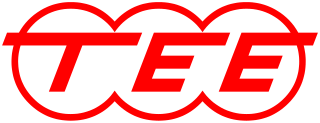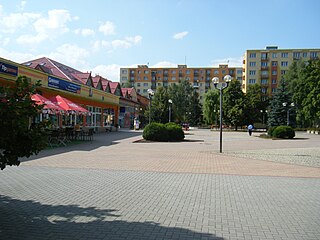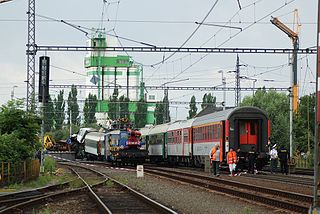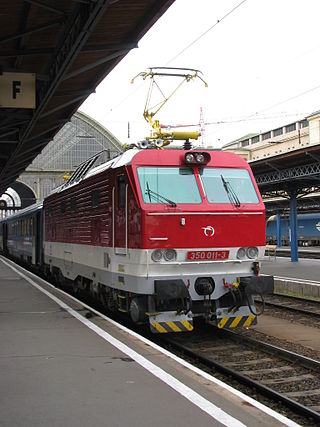| Overview | |
|---|---|
| Service type | EuroCity (EC) |
| Status | Operational |
| Locale | Czech Republic Germany Hungary Poland |
| First service | 23 May 1993 |
| Route | |
| Termini | Praha hl.n. / Budapest Hamburg-Altona / Berlin / Kraków Główny |
| Service frequency | Daily |
| Train number(s) | EC 170/171 / EC 174/175 EC 108/109 / EC 118/119 |
| Technical | |
| Track gauge | 1,435 mm (4 ft 8+1⁄2 in) |
| Electrification | 15 kV AC, 16.7 Hz (Germany) |
The Comenius has been the name of two distinct EuroCity (EC) international express trains, both of them originating, terminating or passing through Prague, the capital of the Czech Republic.
Both of the Comenius trains have been named after John Amos Comenius (1592–1670), a Czech-speaking Moravian teacher, educator and writer.
Introduced in 1993, the first Comenius ran initially between Prague and Berlin, Germany. It was later extended from Prague further south, to Budapest, Hungary, and later still extended again, this time from Berlin to Hamburg, Germany. It was discontinued in 2000. The second Comenius was introduced in 2006, and links Prague with Kraków, Poland.
In May 1993, there was a major reorganisation of the international train services through the Elbe valley. [1] It involved the introduction of four daily EuroCity expresses. Two existing trains, the Hungaria (Budapest–Hamburg) and the Vindobona (Vienna–Berlin) were upgraded to become EuroCity services, the new EC Porta Bohemica replaced another existing train, the Primator (Prague–Berlin), and a new train, the Comenius, was added to the timetable, All of these changes took effect from 23 May 1993. [2]
The EuroCity train numbers originally assigned to the Comenius were EC 170/171, but in June 1997 they were changed to EC 174/175 (a swapping of numbers with the EC Hungaria). [3]
The first Comenius was discontinued in 2000.
The second Comenius was introduced in 2006, and links Prague with Kraków, Poland.
On 8 August 2008, the southbound Comenius was involved in the Studénka train accident near Studénka, Moravian-Silesian Region, Czech Republic. The train derailed and eight people were killed with 64 others injured. [4]
From its inauguration until 27 May 1995, the first Comenius was made up of ČD coaches. From then until the train's withdrawal on 28 May 2000, its coaches were supplied by MÁV.
Until 9 December 2007, the second Comenius, between Prague and Kraków, was operated using ČD and PKP coaches. Since then, there have also been ÖBB coaches in the train.

EuroCity (EC) is an international train category and brand for European inter-city trains that cross international borders and meet criteria covering comfort, speed, food service, and cleanliness. Each EC train is operated by more than one European Union or Swiss rail company, under a multilateral co-operative arrangement, and all EC trains link important European cities with each other.

The Trans Europ Express, or Trans-Europe Express (TEE), was an international first-class railway service in western and central Europe that was founded in 1957 and ceased in 1995. At the height of its operations, in 1974, the TEE network comprised 45 trains, connecting 130 different cities, from Spain in the west to Austria in the east, and from Denmark to Southern Italy.

In the summer of 1939, weeks ahead of the Nazi German and Soviet invasion of Poland the map of both Europe and Poland looked very different from today. The railway network of interwar Poland had little in common with the postwar reality of dramatically changing borders and political domination of the Soviet-style communism, as well as the pre-independence German, Austrian and Russian networks which the Second Polish Republic had partially inherited in 1918 after the end of World War I. The most important junctions in the Polish territory in summer of 1939 were:

Studénka is a town in Nový Jičín District in the Moravian-Silesian Region of the Czech Republic. It has about 9,300 inhabitants. The town is situated on both sides of the historical border between Moravia and Czech Silesia.

Slovenská strela is the name of an express train, first operated by ČSD in Czechoslovakia on the line between Bratislava and Prague.
EuroNight, abbreviated EN, is a European train category that denotes many mainline national and international night train services within the Western and Central European inter-city rail network.

On 8 August 2008, at approximately 10:30 local time, EuroCity train EC 108 Comenius, en route from Kraków, Poland, to Prague, Czech Republic, struck a part of a motorway bridge that had fallen onto the railroad track near the Studénka railway station in the Czech Republic. The train derailed, killing eight people and injuring 64.

The Děčín–Dresden railway, also called the Elbe Valley Railway is an electrified main line in Saxony and the Czech Republic. Formerly called the Saxon-Bohemian State Railway, the line is part of the Dresden to Prague route and is one of Europe's most important trunk routes (Magistralen). It runs along the Elbe Valley from Děčín via Bad Schandau and Pirna to Dresden. The first section of the line was opened in 1848 and is one of the oldest lines in Germany.

Poznań Główny, anglicised to Poznan Main, is the chief railway station for the city of Poznań, Poland's fifth-largest city, and capital of the Greater Poland Province.

RegioJet a.s. is a private Czech provider of passenger rail and bus transport. The company Student Agency, owned by Czech businessman Radim Jančura, is the sole owner. A sister company of the same name, with its registered office in Bratislava, is an operator of passenger rail and bus transport in Slovakia.

Leo Express, formerly Rapid Express, is an open-access train operator in the Czech Republic, established in 2010. It launched inter-city services in November 2012 on the Prague–Ostrava route, on which state-owned operator Czech Railways and open-access operator RegioJet were already running trains.

The Vindobona is an international named passenger train which began service in 1957 between Berlin and Vienna via Dresden and Prague. In later years the route was extended to run from Hamburg via Berlin, Dresden, Prague, Brno and Vienna to Villach. It was named after the ancient settlement of Vindobona on the site of the modern city of Vienna. Labelled as a EuroCity train connection from 1993, services discontinued in 2014.

The Goethe was an express train that, for most of its existence, linked Paris-Est in Paris, France, with Frankfurt Hbf in Frankfurt, Germany. Introduced in 1970, it was operated by the SNCF and the Deutsche Bundesbahn / Deutsche Bahn (DB).

Hungaria is a EuroCity train which runs between Budapest Nyugati and Hamburg - Altona, currently running with coaches of MÁV. It is numbered as EC 172-173 and runs daily, mainly with MÁV owned rolling stocks.

Varsovia, the Neo-Latin word for Warsaw, Poland, has been the name of two distinct EuroCity international express trains, each of them originating and terminating in Warsaw.
The Primator was an international express train. Introduced in 1986, it ran between Prague, then the capital of Czechoslovakia, and East Berlin, then the capital of the German Democratic Republic (GDR).
Mozart was an express train that linked Paris with Vienna via Strasbourg, Stuttgart and Munich. The service began in 1954, as an F-Zug named Mozart Express running between Strasbourg and Salzburg, before being extended ten years later. In 1983 it was re-classified as an FD-Zug and it was added to the EuroCity network in 1989. It operated until 2007, when it was replaced by a TGV service on the newly opened LGV Est. It was named after the composer Wolfgang Amadeus Mozart, and served many cities with which he had an association.
The Porta Bohemica is a EuroCity (EC) international express train. Since December 2014 it is operating between Hamburg-Altona and Budapest Keleti.

The Praha is a EuroCity international express train. Introduced in 1993, it runs between Warsaw, the capital of Poland, and Prague, the capital of the Czech Republic. The train's name, Praha, is the Czech word for Prague.

Wawel is a named international express train. Introduced in 1995 as an InterCity service, it was upgraded to EuroCity category by its operators PKP Intercity and DB Fernverkehr in 2006. The service was withdrawn at the end of 2014 but reintroduced in December 2020.